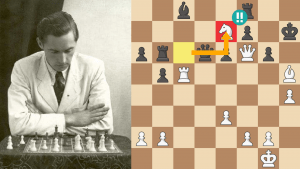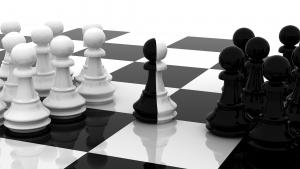
Beware Of Undefended Pieces
There is nothing wrong with your chessboard. Do not attempt to adjust the pieces.
I am controlling the moves. If you wish to speak, I will bring up the volume. If you wish to mutter that all of this is insanity, I will tune it to a whisper. I will control your thoughts. I will control your openings. I can change the color of the board. I can change your chess understanding to a soft blur or sharpen it to crystal clarity. For the next hour sit quietly and I will control all that you see and hear.
I repeat: there is nothing wrong with your chessboard. You are about to participate in a great adventure. You are about to experience the awe and mystery which reaches from the inner chess mind to...THE UNDEFENDED PIECES.

Players from 1600 all the way down to beginner dream of hitting the 2000 mark but, alas, they rarely even get close. Most look at chess books, though they often find that their book isn’t very helpful. Others just play a lot of blitz, hoping that experience will carry them to the promised land. And others think that their chess books were okay, though their rating doesn’t move an inch. Frustrating, isn’t it?
Allow me to help you escape this rut. Ready? Okay, here we go: Put the books down!
Ignore the authorities (I will control your thoughts). In fact, before doing all the stuff everyone recommends, you first need to fix the most deepest, darkest problems in your game.
I’m going to write a couple articles that point out some things that are incredibly simple and obvious, but you don’t know they are there, or you know they are there but think that missing it once in a while is just bad luck.
This first article is all about undefended pieces and pawns. Yes, it sounds like something only beginners have to worry about, but that’s not true at all. In fact, players from 1600 down to beginner constantly leave their pieces floating on the winds, while their opponents are doing the same (yet you don’t notice it and thus miss out on many easy wins).
Here’s an example where a 1422-rated player fell victim to this “undefended pieces and pawns disease."
If you are laughing at this and think you never (or rarely) hang stuff, you’re lying to yourself. In fact, you are doing this often, though you and your opponent might not notice it.
Of course, sometimes leaving things undefended is okay:
Okay, it’s time to leap into the clear blue waters of hangs-ville, while also giving you a glance at our next article: “not bothering to see what the opponent will do.”
One might think that beginners or players under 1600 would have problems finding all those moves. However, all you have to do is recognize the undefended a7 and b7 pawns and then the moves will flow smoothly.
Time for some puzzles!
First, a public service: Whenever I give puzzles, quite a few people don’t realize that they can press the question mark at the bottom left of the board and see various notes. Another bit of puzzle confusion is alternative moves. Yes, there are many situations where there is more than one really good move (or even multiple ways to mate!). When this occurs they think that I missed it. No, I didn’t. The problem is that the software will only allow one "best" move. Fortunately, I will usually have mentioned the moves you were screaming about in the notes!
PUZZLE 1
Okay, let’s see if you can willingly give up material with the understanding that Black’s stuff isn’t very safe either.
PUZZLE 2
PUZZLE 3
Black just played 29...g5 since White was threatening to eat up Black’s f-pawn by Bxf4. Now that Black’s f4-pawn is safe, what can White do?
PUZZLE 4
White has several choices here: 10.Nd4, 10.h3, 10.Bd2, or 10.b4. Out of these four choices, which is the worst?
Sometimes you will overlook that one of your pieces is undefended (happens to everyone). Don’t panic, it might not be a problem or, if it is fatal, you’ll learn something (pain is a powerful teacher!). However, after training yourself to see your and your opponent’s undefended pieces, such things will occur less and less.
In our final game, White noticed that the bishop on c5 was undefended and he jumped on it with glee. Sadly for White, his position was already too far gone and the “combination” led to a quick debacle.
I know that everyone from 1600 to beginner leaves pieces and pawns unprotected. If you want to vastly improve your game you need to train yourself to know if your or your opponent has undefended pieces.
Here’s how you can kill this undefended pieces curse:
- Go through your past games and take note of all the pieces and pawns you and your opponent left undefended. It might horrify you!
- You will discover that you have lost games due to undefended pieces, and failed to win games when your opponents left stuff waiting to be chewed up.
- Do not think that an undefended piece or pawn is always bad. In many cases the opponent can’t punish it. However, if you aren’t completely aware of both side’s undefended pieces then you’re setting yourself up for pain, pain, and more pain.
- One would think this is easy, but (apparently) it’s not. The only way you will grow “undefended piece/pawn eyes" is to insist that you look at each piece and pawn (both sides!). Best is to do this while the opponent’s clock is ticking.
- Master this “simple” thing (seeing undefended pieces or pawns from both sides of the board) and you’ll discover that your overall results have improved enormously.






